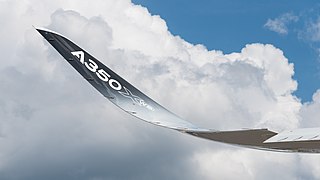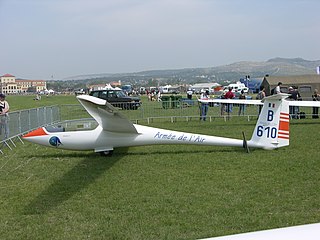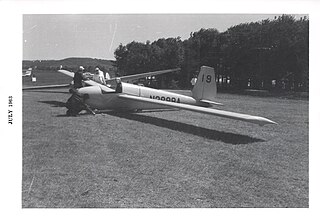
Wingtip devices are intended to improve the efficiency of fixed-wing aircraft by reducing drag. Although there are several types of wing tip devices which function in different manners, their intended effect is always to reduce an aircraft's drag by partial recovery of the tip vortex energy. Wingtip devices can also improve aircraft handling characteristics and enhance safety for following aircraft. Such devices increase the effective aspect ratio of a wing without greatly increasing the wingspan. Extending the span would lower lift-induced drag, but would increase parasitic drag and would require boosting the strength and weight of the wing. At some point, there is no net benefit from further increased span. There may also be operational considerations that limit the allowable wingspan.

A turbulator is a device that turns a laminar boundary layer into a turbulent boundary layer.

The ASW 20 is an FAI 15 metre Class glider designed by Gerhard Waibel and built by Alexander Schleicher GmbH & Co. Its fuselage is nearly identical to that of the ASW 19, mated to newly designed flapped wings for the 15 metre Class. The prototype first flew in 1977. It proved to be a highly successful glider, winning several World Championships, and was still being flown at this level up to 1995. Developments along its production life included winglets, pneumatic turbulators, and wingtip extensions. It remained in production until 1990, when it was superseded by the ASW 27. 765 were built by Schleicher and a further 140 were made under license by Centrair in France.

The Centrair C101 Pegase is a Standard Class single-seat glider manufactured by Centrair starting in 1981. The design uses the ASW 19 fuselage with a new wing designed by ONERA, giving better performance than the German original.

The ASW 24 is a modern single-seat high-performance composite Standard Class sailplane. It is manufactured in Germany by Alexander Schleicher GmbH & Co.

Peter C. Masak was an engineer, inventor, and glider pilot. He graduated with a Bachelor of Applied Science degree in mechanical engineering in May 1981 from the University of Waterloo, Ontario, Canada. He earned his glider pilot license at the age of 16 and his power pilot license at the age of 18, the minimum ages for both. Peter was a Canadian soaring record holder and represented Canada and later the United States in the World Gliding Championships. He logged almost 2000 hours of glider flight time. He was living in West Chester, Pennsylvania with his wife Adrienne and their three children when he died.

The Schweizer SGS 1-29 is an American single-seat, mid-wing, experimental laminar flow airfoil glider built by Schweizer Aircraft of Elmira, New York.

The Schweizer SGS 1-35 is a United States 15 Meter Class, single-seat, mid-wing glider built by Schweizer Aircraft of Elmira, New York.
Richard H. Johnson was a glider pilot, aeronautical engineer and prolific writer of articles for gliding magazines. He was an 11-time U.S. National Champion glider pilot, 9-time US Soaring Team pilot at the Soaring World Championships, held two World Gliding Records and is a member of the US Soaring Hall of Fame. He flew for 70 years and logged over 14,000 flying hours, including over 10,000 hours of non-powered flight time in sailplanes. He authored over 100 articles on soaring and flight tests of gliders.

The Slingsby T.37 Skylark 1 was a small low-cost sailplane built during 1952-3 at Kirbymoorside, Yorkshire by Slingsby Sailplanes.

August Raspet was an American aerodynamicist and researcher. He was one of the most influential contributors to the science of aeronautics, dealing primarily with efficiency in flight, aerodynamics and wing design structures. His contributions to the field of flight science are many, having published over forty scholarly articles on subjects ranging from human muscle-powered flight to sailplane performance analysis as it relates to airplanes. An avid bird watcher, Raspet developed his dedication to the idea of flight from a young age and would use ideas generated from observing avian flight in his experiments and research throughout his career.

The DFS Weihe is a German single-seat, high-wing, 18 metre wingspan, high-performance glider that was designed by Hans Jacobs in 1937-38.
The Ross RH-3 is a single seat, mid-wing glider that was designed by Harland Ross.
The Laister LP-46 and LP-49 are a family of American high-wing, single-seat, gliders that were designed by Jack Laister and produced by Laister Sailplanes both as kit aircraft and as certified complete aircraft.
The Prue Super Standard is an American, high-wing, single-seat, FAI Standard Class glider that was designed by Irving Prue in 1962 as a development of the Prue Standard.

The Hütter Hü 17, is a German high-wing, strut-braced, single-seat, utility training glider that was designed by brothers Ulrich Hütter and Wolfgang Hütter in the 1930s.

The Schleicher Ka-4 Rhönlerche II, sometimes called the KA-4 or even K 4, is a West German high-wing, strut-braced, two-seat glider that was designed by Rudolf Kaiser and produced by Alexander Schleicher GmbH & Co.

The Masak Scimitar was an American mid-wing, single-seat glider that was designed and constructed by Peter Masak. It first flew in 1995.
John H. McMasters was an aeronautical engineer notable for his contributions to aerodynamics and engineering education.

The HKS-1 was a German 19 19 m (62.3 ft) span high performance two seat sailplane, designed around 1950 to use recent advances in laminar flow airfoils. To avoid premature transition from laminar flow caused by surface interruptions, the HKS-1 dispensed with hinged ailerons, flaps and spoilers and replaced them with a flexible trailing edge. Two were built, setting several records.














